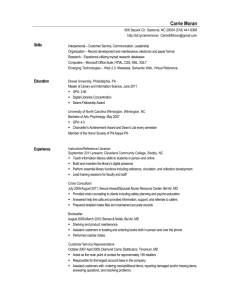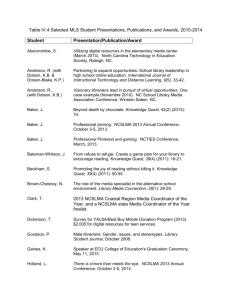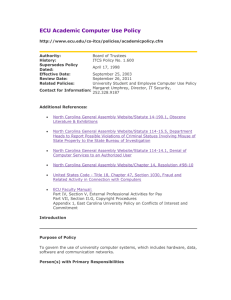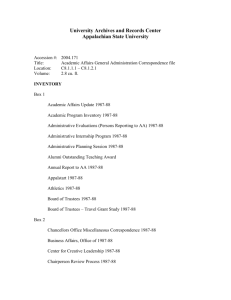2008 GSA Grant Proposal - North Carolina State University
advertisement
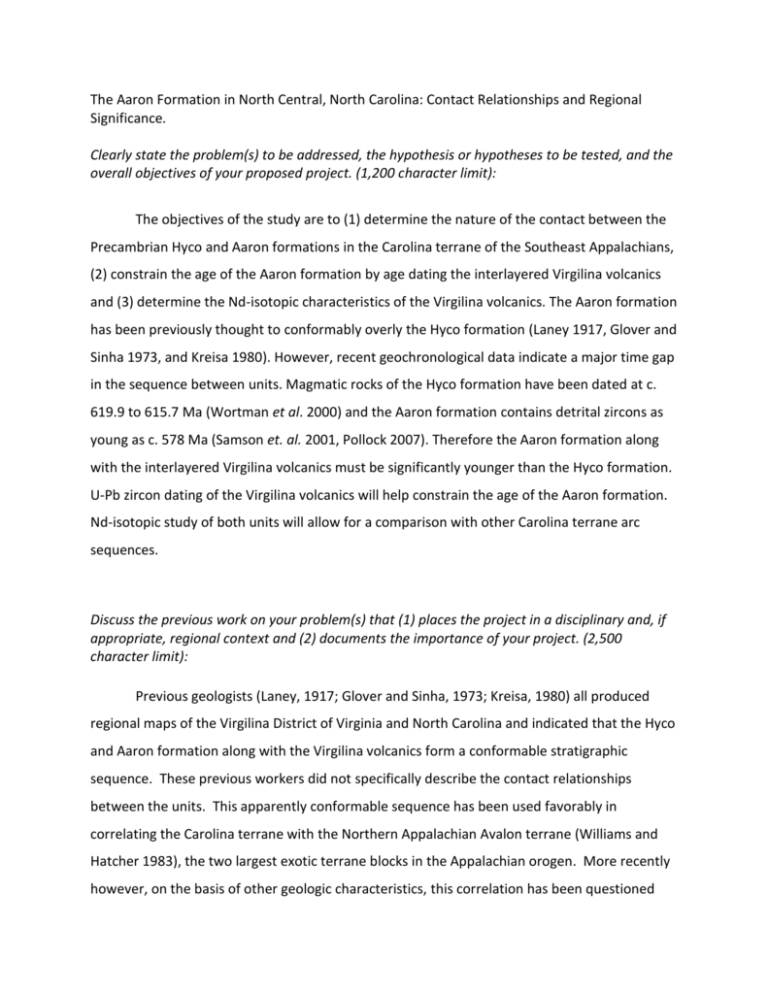
The Aaron Formation in North Central, North Carolina: Contact Relationships and Regional Significance. Clearly state the problem(s) to be addressed, the hypothesis or hypotheses to be tested, and the overall objectives of your proposed project. (1,200 character limit): The objectives of the study are to (1) determine the nature of the contact between the Precambrian Hyco and Aaron formations in the Carolina terrane of the Southeast Appalachians, (2) constrain the age of the Aaron formation by age dating the interlayered Virgilina volcanics and (3) determine the Nd-isotopic characteristics of the Virgilina volcanics. The Aaron formation has been previously thought to conformably overly the Hyco formation (Laney 1917, Glover and Sinha 1973, and Kreisa 1980). However, recent geochronological data indicate a major time gap in the sequence between units. Magmatic rocks of the Hyco formation have been dated at c. 619.9 to 615.7 Ma (Wortman et al. 2000) and the Aaron formation contains detrital zircons as young as c. 578 Ma (Samson et. al. 2001, Pollock 2007). Therefore the Aaron formation along with the interlayered Virgilina volcanics must be significantly younger than the Hyco formation. U-Pb zircon dating of the Virgilina volcanics will help constrain the age of the Aaron formation. Nd-isotopic study of both units will allow for a comparison with other Carolina terrane arc sequences. Discuss the previous work on your problem(s) that (1) places the project in a disciplinary and, if appropriate, regional context and (2) documents the importance of your project. (2,500 character limit): Previous geologists (Laney, 1917; Glover and Sinha, 1973; Kreisa, 1980) all produced regional maps of the Virgilina District of Virginia and North Carolina and indicated that the Hyco and Aaron formation along with the Virgilina volcanics form a conformable stratigraphic sequence. These previous workers did not specifically describe the contact relationships between the units. This apparently conformable sequence has been used favorably in correlating the Carolina terrane with the Northern Appalachian Avalon terrane (Williams and Hatcher 1983), the two largest exotic terrane blocks in the Appalachian orogen. More recently however, on the basis of other geologic characteristics, this correlation has been questioned (Secor et. al. 1983, Hibbard et. al. 2002, 2007). Recent geochronology indicates a significant time gap between the Hyco and Aaron formations. If the contact is discovered to be an angular unconformity, it would suggest that a significant deformational event took place in the Carolina terrane that is not recorded in the Avalon terrane. This would favorably support the noncorrelation of the Carolina terrane with the Avalon terrane. In addition to the U-Pb zircon age dating of the Virgilina volcanics, the Nd-isotopic analysis of the Aaron formation and Virgilina volcanics should allow me to determine if these units are related to the older Hyco arc or if they are linked to a younger Carolina terrane arc sequence, the Albemarle arc. Concisely state how you plan to address your problem(s) and test your hypothesis or hypotheses (2,500 character limit): In order to attain my objectives, I will undertake field and lab studies. My first step will be unprecedented detailed geologic mapping of the contacts between the units mentioned above. I will traverse the contacts and pay particular attention to the concordancy/discordancy of beds and presence or absence of fault products. Once the contact of the two units has been found and mapped, the nature of the contact can be deduced from the observations. The field mapping will also identify fresh outcrops of the Virgilina volcanics which are suitable for U-Pb zircon dating. In addition to the dating, Nd isotopic work will also be carried out in order to compare the Virgilina volcanics with both older (Hyco formation) and younger arc rocks of the Carolina terrane. I will be collaborating with Dr. Brent Miller of Texas A&M University for my Nd-isotopic analysis and with his new U-Pb geochronology laboratory. In summary, my work is directed at determining the nature of the contact, such as any angular unconformity that may have recorded a major deformational event. Also, my work will determine the age and Nd-isotopic characteristics of the Aaron formation and Virgilina volcanics to compare with other exotic Appalachian arc rocks. The findings from this project will provide further data toward determining the relationship between the Carolina and the Avalon terranes. Duration of investigation (dates): January 2008 – December 2009 Budget justification (1,200 character limit): U-Pb Zircon Age Dating ..……………………………………………………………………………….. $ 900.00 U-Pb zircon age date of Virgilina volcanics, 1 age date @ $900.00 Isotopic Analysis ..………………………………………………………………………………………….. $ 750.00 Nd-isotopic analysis, 5 analysis @ $150.00 each Lodging ………………………………………………………………………………………………………….. $ 500.00 Camping fees, county park available near field area, $50.00/week (10 weeks) Thin sections ………………………………………………………………………………………………….. $ 600.00 40 @ $15.00 each Topographic Maps ..……………………………………………………………………………………….. $ 24.00 6 maps @ $4.00 each Food ………………………………………………………………………………………………………………. $ 1400.00 Food per diem, $20.00/day (70 days) Travel ……………………………………………………………………………………………………………. $ 534.00 To and from the field area once or twice a week, Roundtrip ~ 120 mi., $0.445/mile (~ 1200 mi) Total ……………………………….………………………………………………………………………………. $ 4708.00 Amount and nature of other available funds, facilities, materials, etc. (1,200 character limit): Limited funds from a National Science Foundation grant awarded to Dr. Jim Hibbard that is almost fully expended will cover $2,000.00 of my food and travel expenses. Abbreviated resume. List education, major positions held, and significant accomplishments. Provide information relevant to your qualifications to undertake proposed research. List up to 5 of your publications and presentations (2,500 character limit): Education: 1/9/2008 - Present 2003 – 2007 North Carolina State University, Raleigh, NC 27606 Masters Candidate in Geological Sciences Indiana University, Bloomington, IN 47403 Bachelor of Science – Geological Sciences Geology GPA: 3.91/4.0 Overall GPA: 3.11/4.0 Skills: Scientific lab and field work experience, Geologic mapping and Geochemical Analysis Employment: Park Ranger, Black Canyon of Gunnison National Park, Gunnison, CO September 2007 – November 2007 Environmental education programs, k-12 Assistant Instructor, Judson Meade Indiana University Geologic Field Station, Cardwell, MT June 2007 – August 2007 Help students in the field with a variety of mapping exercises Field Technician, Indiana Geological Survey, Bloomington, IN May – August 2005 Worked independently collecting well data, Gamma Log Program Assistant, Wonderlab Science Museum , Bloomington, IN Honors Internship 2004 – 2007 Facilitate & develop programs for kids Research and develop new activities Assist in development of geology demo Projects: Extensive structural and geologic mapping of Southwest Montana, Indiana University Geologic Field Station. Undergrad Senior Project – sample collection, geochemical analysis, and poster Publication: Bowman, Jeffrey D., 2007. Asthenospheric Upwelling and Slab Roll-Back of the Subducting Avalon Plate: Geochemical Evidence from the Lebanon Gabbro, East-Central Connecticut, GSA Abstracts with Programs Vol. 39, No. 1, p. 76 Accomplishments: Co-Founder & Vice President IU Geology Club, Undergraduate Representative for department Student Advisory Committee, Raised over $900 for IU Geology Club, Published abstract for NE Geological Society of America conference as an undergraduate References cited in proposal (2,500 character limit): Glover, Lynn, III, and Sinha, A. K., 1973, The Virgilina deformation, a late Precambrian to Early Cambrian(?) orogenic event in the central Piedmont of Virginia and North Carolina: American Journal of Science, v. 273-A, p. 234-251 Hibbard, J., Stoddard, E., Secor, D., and Dennis, A., 2002, The Carolina Zone: overview of Neoproterozoic to early Paleozoic peri-Gondwanan terranes along with eastern flank of the southern Appalachian: Earth Science Reviews, v. 57, p. 299-339. Hibbard, J. P., van Staal, C. R., and Miller, B. V., 2007, Links between Carolina, Avalonia, and Ganderia in the Appalachian per-Gondwanan realm: Geological Survey of Canada Map 02096A, 2 sheets, scale 1:1,500,000. Kreisa, R. D., 1980. Geology of the Omega, South Boston, Cluster Springs, and Virgilina quadrangles, Virginia. Va. Div. Miner. Resour. Publ. 5, 22 p. Laney, F. B., 1917, The geology and ore deposits of the Virgilina District of Virginia and North Carolina: Virginia Geol. Survey Bull. 14, 176 p.; also pub. As North Carolina Geol. And Econ. Survey Bull. 26. Pollock, J. C., 2007, Depositional and tectonic setting of the Neoproterozoic early Paleozoic rocks of Carolina: Evolution of volcanic arc-related sedimentary sequences based on UPb detrital zircon geochronology. PHD Dissertation, North Carolina State University, Raleigh, NC, 194 p. Samson, Scott D., Secor, D. T., 2001, Wandering Carolina: Tracking exotic terranes with detrital Zircons, GSA Abstracts with Programs Vol. 33, No. 6, p. A-263 Secor, D., Samson, S. L., Snoke, A. W.; and Palmer, A. R. 1983. Confirmation of the Carolina slate belt as an exotic terrane. Science 221:649-651. Williams, H. and Hatcher, R.D., Jr., 1983, Appalachian suspect terranes, in Hatcher, R.D., Jr., Williams, H. and Zietz, I., eds., Contributions to the Tectonics and Geophysics of Mountain Chains: Geological Society of America, Memoir 158, p. 33-53. Wortman, G., Samson, S., Hibbard, J., 2000. Precise U-Pb zircon constraints on the earliest magmatic history of the Carolina terrane. Journal of Geology 108, 321-338.





